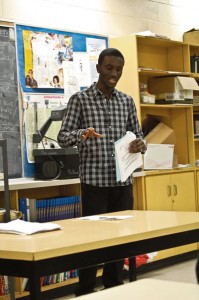No Colour, One Blood
No Colour, One Blood
Youth Multicultural Program for Diversity Awareness
By Beatrice S. Paez
If the Jane and Finch area was a village of sorts, Francis Atta would be one of its youth ambassadors. Atta is a familiar face in his community, wading through the wings of its mall and neighbouring streets with ease, slapping hands and greeting people as he makes his way to his next gig.
His brainchild, No Colour One Blood, a multicultural program for youth that aims to increase their understanding and appreciation for Toronto’s diverse communities, is an after school special for many kids.
Every week, on Mondays, Wednesdays and Fridays, about 20 children, grades 7 to 12, gather at Firgrove Community Centre to learn about Toronto’s cultural makeup, taking on a different racial or ethnic heritage each week.
“I want to teach them to be diverse, to be able to get along with everybody, not just their own kind,” says Atta who runs the program. “We teach them about respect.”
Ask these kids why they keep coming back, and they say it’s because he makes learning about different cultures engaging. Atta’s program provides a safe, familial environment where kids can be kids — cracking jokes and splitting candy with one another.
They even dine as a family, every Wednesdays a meal from a different culture is served to complement their discussions. On Halloween, Atta’s mother came to cook jollof rice, a dish popular in West Africa but which originated in Ghana, where his family emigrated.
But before this treat, the kids are asked to dig into their perceptions about the life and culture of the communities explored in their lesson. With Africa as the choice of the week, they are encouraged to share what they know and what they are interested in learning.
He blends music and icebreakers into his lesson plan, introducing them to different customs and speaking to them about the lives of other children.
Having grown up in Jane and Finch, Atta says he is able to speak to the children at a level they can relate to because he lived through the struggle of determining his direction. If there’s one thing he hopes to impart to them as a role model figure, it’s to take advantage of opportunities to grow.
“I had a lot of people along the way [to help], I was so close to not making it. I was doing a lot of things that was getting me in trouble, ” he says. “I’m just trying to educate these kids to be leaders, so that the torch can be passed onto them.”
It was his father and high school teacher, Mr. Raso who propelled him forward. Stern and unflinching, Raso was hard on Atta as a student because he would show up to class with unfinished homework. But it was his teacher who helped brand his business as a motivational speaker, naming it K.E.Y.S. for Knowledge & Effort Yield Success. Today he works alongside Raso as a child and youth worker for the Toronto Catholic District School Board.
As a child and youth worker, Atta is working to change people’s perceptions about his neighbourhood. And for him, it starts with the kids not allowing themselves to be defined by the area’s reputation.
While other people may view living in Jane and Finch as a dead end path, rife with gun violence and street crime, Atta only sees opportunities. “I’m from Jane and Finch, and that motivates me,” he says.
Just fresh off from wrapping up his education at George Brown, Atta is already adept at devising creative ways to communicate his messages to the children he works with. Since the program rebooted in September, he has been planning to take the kids on Friday excursions to sporting, cultural and leadership events.
One Friday after school, he took them paint balling. His colleagues were stunned by the decision, given the area’s headline-grabbing reputation for gun crime. But he assured them he had his reasons.
After a night of fun, he sat the kids down, and told them, “Today you got shot with paint balls, and you get to go home. But tomorrow if you get shot, you don’t get to go home.”
He says he hoped it touched some nerves, jolting them into realizing the importance of staying away from the wrong crowd and attending class.
He sees himself reflected in the kids he mentors and hopes one day, one of the kids will take on his role, “All these kids, they’re a part of me. All these kids are just like me.”

Comments (0)